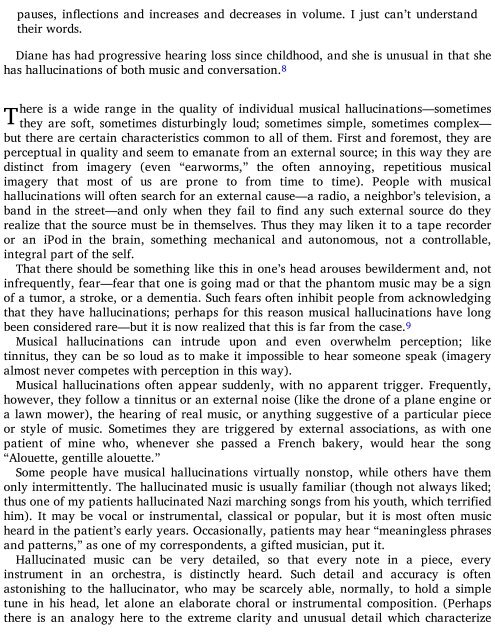32896589326509350
You also want an ePaper? Increase the reach of your titles
YUMPU automatically turns print PDFs into web optimized ePapers that Google loves.
pauses, inections and increases and decreases in volume. I just can’t understand<br />
their words.<br />
Diane has had progressive hearing loss since childhood, and she is unusual in that she<br />
has hallucinations of both music and conversation. 8<br />
T<br />
here is a wide range in the quality of individual musical hallucinations—sometimes<br />
they are soft, sometimes disturbingly loud; sometimes simple, sometimes complex—<br />
but there are certain characteristics common to all of them. First and foremost, they are<br />
perceptual in quality and seem to emanate from an external source; in this way they are<br />
distinct from imagery (even “earworms,” the often annoying, repetitious musical<br />
imagery that most of us are prone to from time to time). People with musical<br />
hallucinations will often search for an external cause—a radio, a neighbor’s television, a<br />
band in the street—and only when they fail to nd any such external source do they<br />
realize that the source must be in themselves. Thus they may liken it to a tape recorder<br />
or an iPod in the brain, something mechanical and autonomous, not a controllable,<br />
integral part of the self.<br />
That there should be something like this in one’s head arouses bewilderment and, not<br />
infrequently, fear—fear that one is going mad or that the phantom music may be a sign<br />
of a tumor, a stroke, or a dementia. Such fears often inhibit people from acknowledging<br />
that they have hallucinations; perhaps for this reason musical hallucinations have long<br />
been considered rare—but it is now realized that this is far from the case. 9<br />
Musical hallucinations can intrude upon and even overwhelm perception; like<br />
tinnitus, they can be so loud as to make it impossible to hear someone speak (imagery<br />
almost never competes with perception in this way).<br />
Musical hallucinations often appear suddenly, with no apparent trigger. Frequently,<br />
however, they follow a tinnitus or an external noise (like the drone of a plane engine or<br />
a lawn mower), the hearing of real music, or anything suggestive of a particular piece<br />
or style of music. Sometimes they are triggered by external associations, as with one<br />
patient of mine who, whenever she passed a French bakery, would hear the song<br />
“Alouette, gentille alouette.”<br />
Some people have musical hallucinations virtually nonstop, while others have them<br />
only intermittently. The hallucinated music is usually familiar (though not always liked;<br />
thus one of my patients hallucinated Nazi marching songs from his youth, which terrified<br />
him). It may be vocal or instrumental, classical or popular, but it is most often music<br />
heard in the patient’s early years. Occasionally, patients may hear “meaningless phrases<br />
and patterns,” as one of my correspondents, a gifted musician, put it.<br />
Hallucinated music can be very detailed, so that every note in a piece, every<br />
instrument in an orchestra, is distinctly heard. Such detail and accuracy is often<br />
astonishing to the hallucinator, who may be scarcely able, normally, to hold a simple<br />
tune in his head, let alone an elaborate choral or instrumental composition. (Perhaps<br />
there is an analogy here to the extreme clarity and unusual detail which characterize

















